A Green Triboelectric Nano-Generator Composite of Degradable Cellulose, Piezoelectric Polymers of PVDF/PA6, and Nanoparticles of BaTiO3
Abstract
1. Introduction
2. Experimental Preparation and Operating Principle
2.1. Experimental Materials
2.2. The Preparation of Different Types of Composite Cellulose Layers
2.3. Operating Principle
3. Performance Testing and Analysis
3.1. FT-IR/XRD Characterization Analysis
3.2. CV (Cyclic Voltammetry) Test Analysis
3.3. EIS and GCD Test Analysis
3.4. Single Open Circuit Voltage/Short Circuit Current Test
3.5. Multiple Combined Open Circuit Voltage/Short Circuit Current Test
3.6. Charge and Discharge Test
4. Conclusions
Author Contributions
Funding
Conflicts of Interest
References
- Karan, S.K.; Maiti, S.; Agrawal, A.K.; Das, A.K.; Maitra, A.; Paria, S.; Bera, A.; Bera, R.; Halder, L.; Mishra, A.K.; et al. Designing high energy conversion efficient bio-inspired vitamin assisted single-structured based self-powered piezoelectric/wind/acoustic multi-energy harvester with remarkable power density. Nano Energy 2019, 59, 169–183. [Google Scholar] [CrossRef]
- Liu, X.; Zhao, K.; Yang, Y. Effective polarization of ferroelectric materials by using a triboelectric nanogenerator to scavenge wind energy. Nano Energy 2018, 53, 622–629. [Google Scholar] [CrossRef]
- Chen, B.; Yang, Y.; Wang, Z.L. Scavenging Wind Energy by Triboelectric Nanogenerators. Adv. Energy Mater. 2018, 8, 10. [Google Scholar]
- Qian, J.G.; Jing, X.J. Wind-driven hybridized triboelectric-electromagnetic nanogenerator and solar cell as a sustainable power unit for self-powered natural disaster monitoring sensor networks. Nano Energy 2018, 52, 78–87. [Google Scholar] [CrossRef]
- Hou, H.D.; Xu, Q.K.; Pang, Y.K.; Hou, H.D.; Xu, Q.K.; Pang, Y.K.; Li, L.; Wang, J.L.; Zhang, C.; Sun, C.W. Efficient Storing Energy Harvested by Triboelectric Nanogenerators Using a Safe and Durable All-Solid-State Sodium-Ion Battery. Adv. Sci. 2017, 4, 8. [Google Scholar] [CrossRef]
- Yuan, Z.Q.; Du, X.Y.; Li, N.W.; Yin, Y.Y.; Cao, R.; Zhang, X.L.; Zhao, S.Y.; Niu, H.D.; Jiang, T.; Xu, W.H.; et al. Triboelectric-Based Transparent Secret Code. Adv. Sci. 2018, 5, 4. [Google Scholar] [CrossRef]
- Pu, X.; Liu, M.M.; Li, L.X.; Zhang, C.; Pang, Y.K.; Jiang, C.Y.; Shao, L.H.; Hu, W.G.; Wang, Z.L. Efficient Charging of Li-Ion Batteries with Pulsed Output Current of Triboelectric Nanogenerators. Adv. Sci. 2016, 3, 1. [Google Scholar] [CrossRef]
- Kuang, S.Y.; Zhu, G.; Wang, Z.L. Triboelectrification-Enabled Self-Powered Data Storage. Adv. Sci. 2018, 5, 2. [Google Scholar] [CrossRef]
- Yin, Y.Y.; Zhang, X.L.; Du, X.Y.; Zhou, T.; Li, N.W.; Xu, W.H.; Li, C.J. Efficient Charging of Lithium-Sulfur Batteries by Triboelectric Nanogenerator Based on Pulse Current. Adv. Mater. Technol. 2019, 4, 2. [Google Scholar] [CrossRef]
- Han, S.; Kim, J.; Won, S.M.; Ma, Y.J.; Kang, D.; Xie, Z.Q.; Lee, K.; Chung, H.U.; Banks, A.; Min, S.; et al. Battery-free, wireless sensors for full-body pressure and temperature mapping. Sci. Transl. Med. 2018, 10, 435. [Google Scholar] [CrossRef]
- Liu, Y.H.; Norton, J.J.S.; Qazi, R.; Zou, Z.N.; Ammann, K.R.; Liu, H.; Yan, L.K.; Tran, P.L.; Jang, K.; Lee, J.W.; et al. Epidermal mechano-acoustic sensing electronics for cardiovascular diagnostics and human-machine interfaces. Sci. Adv. 2016, 2, 11. [Google Scholar] [CrossRef] [PubMed]
- Gao, W.; Emaminejad, S.; Nyein, H.Y.Y.; Challa, S.; Chen, K.; Peck, A.; Fahad, H.M.; Ota, H.; Shiraki, H.; Kiriya, D.; et al. Fully integrated wearable sensor arrays for multiplexed in situ perspiration analysis. Nature 2016, 529, 169–183. [Google Scholar] [CrossRef] [PubMed]
- Salauddin, M.; Toyabur, R.M.; Maharjan, P.; Park, J.Y. High performance human-induced vibration driven hybrid energy harvester for powering portable electronics. Nano Energy 2018, 45, 236–246. [Google Scholar] [CrossRef]
- Jiang, S.; Agarwal, S.; Greiner, A. Low-Density Open Cellular Sponges as Functional Materials. Angew. Chem. Int. Ed. 2017, 56, 15520–15538. [Google Scholar] [CrossRef] [PubMed]
- Lee, J.H.; Park, J.Y.; Cho, E.B.; Kim, T.Y.; Han, S.A.; Kim, T.H.; Liu, Y.N.; Kim, S.K.; Roh, C.J.; Yoon, H.J.; et al. Reliable Piezoelectricity in Bilayer WSe2 for Piezoelectric Nanogenerators. Adv. Mater. 2017, 29, 29. [Google Scholar] [CrossRef]
- Han, S.A.; Kim, T.H.; Kim, S.K.; Lee, K.H.; Park, H.; Lee, J.; Kim, S. Point-Defect-Passivated MoS2 Nanosheet-Based High Performance Piezoelectric Nanogenerator. Adv. Mater. 2018, 30, 21. [Google Scholar] [CrossRef]
- Zheng, Q.; Shi, B.J.; Li, Z.; Wang, Z.L. Recent Progress on Piezoelectric and Triboelectric Energy Harvesters in Biomedical Systems. Adv. Sci. 2017, 4, 7. [Google Scholar] [CrossRef]
- Zhang, K.W.; Wang, S.H.; Yang, Y. A One-Structure-Based Piezo-Tribo-Pyro Photoelectric Effects Coupled Nanogenerator for Simultaneously Scavenging Mechanical, Thermal, and Solar Energies. Adv. Energy Mater. 2017, 7, 6. [Google Scholar]
- Chu, Y.; Zhong, J.W.; Liu, H.L.; Ma, Y.; Liu, N.; Song, Y.; Liang, J.M.; Shao, Z.C.; Sun, Y.; Dong, Y.; et al. Human Pulse Diagnosis for Medical Assessments Using a Wearable Piezoelectret Sensing System. Adv. Funct. Mater. 2018, 28, 40. [Google Scholar] [CrossRef]
- Song, H.B.; Karakurt, I.; Wei, M.S.; Liu, N.; Chu, Y.; Zhong, J.W.; Lin, L.Y. Lead iodide nanosheets for piezoelectric energy conversion and strain sensing. Nano Energy 2018, 49, 7–13. [Google Scholar] [CrossRef]
- Ouyang, H.; Tian, J.J.; Sun, G.L.; Zou, Y.; Liu, Z.; Li, H.; Zhao, L.M.; Shi, B.J.; Fan, Y.B.; Fan, Y.F.; et al. Self-Powered Pulse Sensor for Antidiastole of Cardiovascular Disease. Adv. Mater. 2017, 29, 40. [Google Scholar] [CrossRef] [PubMed]
- Cheon, S.; Kang, H.; Kim, H.; Son, Y.G.; Lee, J.Y.; Shin, H.; Kim, S.; Cho, J.H. High-Performance Triboelectric Nanogenerators Based on Electrospun Polyvinylidene Fluoride-Silver Nanowire Composite Nanofibers. Adv. Funct. Mater. 2018, 28, 2. [Google Scholar] [CrossRef]
- Chen, X.Y.; Wu, Y.L.; Yu, A.F.; Xu, L.; Zheng, L.; Liu, Y.S.; Li, H.X.; Wang, Z.L. Self-powered modulation of elastomeric optical grating by using triboelectric nanogenerator. Nano Energy 2017, 38, 91–100. [Google Scholar] [CrossRef]
- Yoon, H.J.; Ryu, H.; Kim, S.W. Sustainable powering triboelectric nanogenerators: Approaches and the path towards efficient use. Nano Energy 2018, 51, 270–285. [Google Scholar] [CrossRef]
- Chen, Y.D.; Jie, Y.; Wang, J. Triboelectrification on natural rose petal for harvesting environmental mechanical energy. Nano Energy 2018, 50, 441–447. [Google Scholar] [CrossRef]
- Chen, X.Y.; Pu, X.; Jiang, T.; Xu, L.; Zheng, L.; Liu, Y.S.; Li, H.X.; Wang, Z.L. Tunable Optical Modulator by Coupling a Triboelectric Nanogenerator and a Dielectric Elastomer. Adv. Funct. Mater. 2017, 27, 1. [Google Scholar] [CrossRef]
- Hinchet, R.; Ghaffarinejad, A.; Lu, Y.X.; Hasanic, J.Y.; Kim, S.; Basset, P. Understanding and modeling of triboelectric-electret nanogenerator. Nano Energy 2018, 47, 401–409. [Google Scholar] [CrossRef]
- Chen, J.; Guo, H.Y.; Pu, X.J.; Wang, X.; Xia, Y.; Hua, C.G. Traditional weaving craft for one-piece self-charging power textile for wearable electronics. Nano Energy 2018, 50, 536–543. [Google Scholar] [CrossRef]
- Feng, L.; Liu, G.L.; Guo, H.Y.; Tang, Q.; Pu, X.J.; Chen, J.; Wang, X.; Xi, Y.; Hu, C.G. Hybridized nanogenerator based on honeycomb-like three electrodes for efficient ocean wave energy harvesting. Nano Energy 2018, 47, 217–223. [Google Scholar] [CrossRef]
- Wang, X.; Yang, Y. Effective energy storage from a hybridized electromagnetic-triboelectric nanogenerator. Nano Energy 2017, 32, 36–41. [Google Scholar] [CrossRef]
- Wang, X.F.; Niu, S.M.; Yin, Y.J.; Yi, F.; You, Z.; Wang, Z.L. Triboelectric Nanogenerator Based on Fully Enclosed Rolling Spherical Structure for Harvesting Low-Frequency Water Wave Energy. Adv. Energy Mater. 2015, 5, 24. [Google Scholar]
- Toyabur, R.M.; Salauddin, M.; Cho, H.; Park, J.Y. A multimodal hybrid energy harvester based on piezoelectric-electromagnetic mechanisms for low-frequency ambient vibrations. Energy Convers. Manag. 2018, 168, 454–466. [Google Scholar] [CrossRef]
- Ding, Y.; Guo, X.; Ramirez-Meyers, K.; Zhou, Y.G.; Zhang, L.Y.; Zhao, F.; Yu, G.H. Simultaneous energy harvesting and storage via solar-driven regenerative electrochemical cycles. Energy Environ. Sci. 2019, 12, 3370–3379. [Google Scholar] [CrossRef]
- Paria, S.; Si, S.K.; Karan, S.K.; Das, A.K.; Maitra, A.; Bera, R.; Halder, L.; Bera, A.; De, A.; Khatua, B.B. A strategy to develop highly efficient TENGs through the dielectric constant, internal resistance optimization, and surface modification. J. Mater. Chem. A 2019, 7, 3979–3991. [Google Scholar] [CrossRef]
- Gao, S.; Wang, M.; Chen, Y.; Tian, M.; Zhu, Y.Z.; Wei, X.J.; Jiang, T. An advanced electro-Fenton degradation system with triboelectric nanogenerator as electric supply and biomass-derived carbon materials as cathode catalyst. Nano Energy 2018, 45, 21–27. [Google Scholar] [CrossRef]
- Zhang, C.; Lin, X.; Zhang, N.; Zhang, C.Y.; Lin, X.J.; Zhang, N.; Lu, Y.; Wu, Z.M.; Liu, G.L.; Nie, S.X. Chemically functionalized cellulose nanofibrils-based gear-like triboelectric nanogenerator for energy harvesting and sensing. Nano Energy 2019, 66, 104126. [Google Scholar] [CrossRef]
- Wang, Z.F.; Smith, A.T.; Wang, W.X.; Sun, L.Y. Versatile Nanostructures from Rice Husk Biomass for Energy Applications. Angew. Chem. Int. Ed. 2018, 57, 13722–13734. [Google Scholar] [CrossRef]
- Tian, M.; Zhu, Y.Z.; Zhang, D.L.; Wang, M.; Chen, Y.; Yang, Y.J.; Gao, S.Y. Pyrrolic-nitrogen-rich biomass-derived catalyst for sustainable degradation of organic pollutant via a self-powered electro-Fenton process. Nano Energy 2019, 64, 103940. [Google Scholar] [CrossRef]
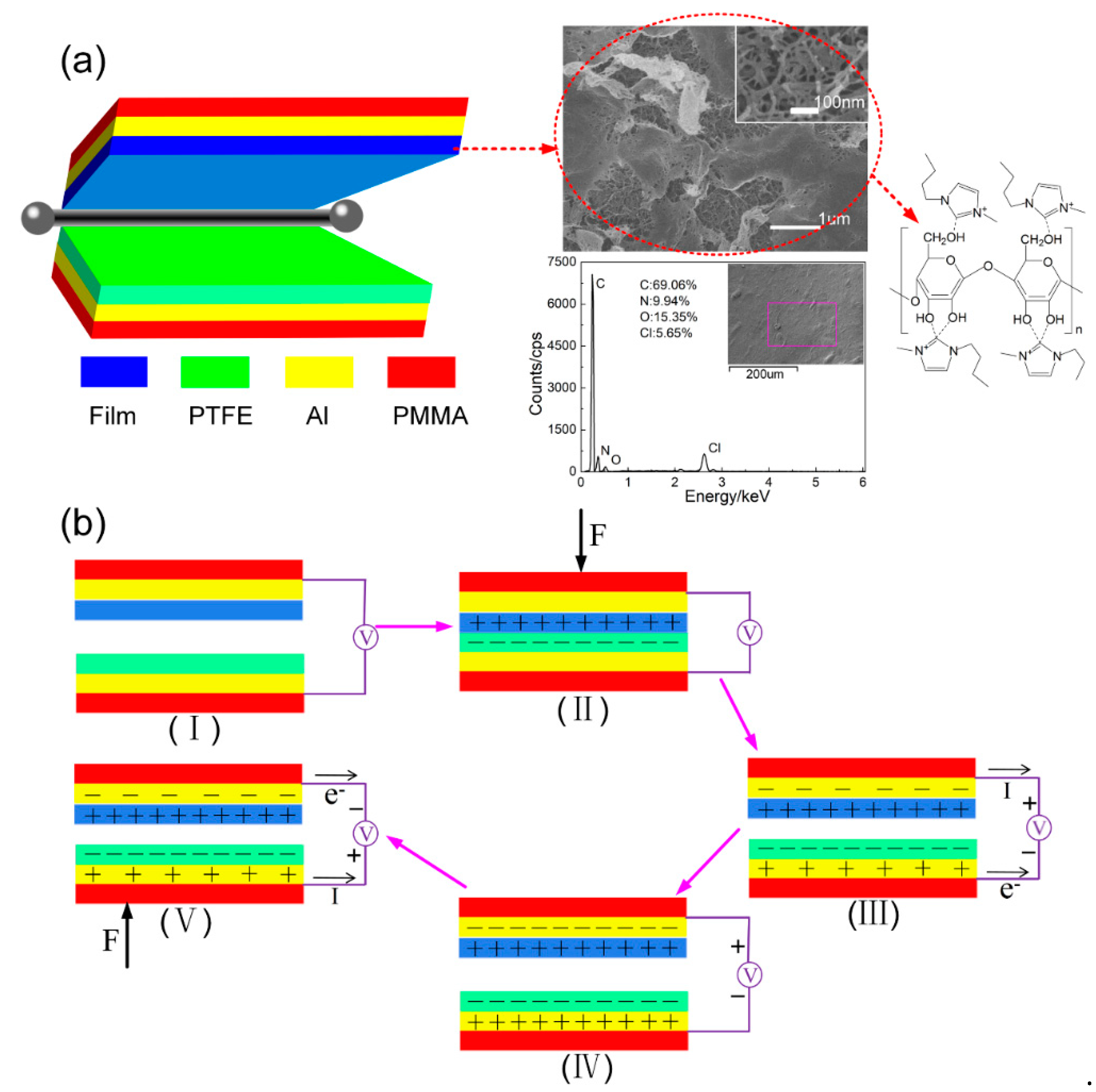

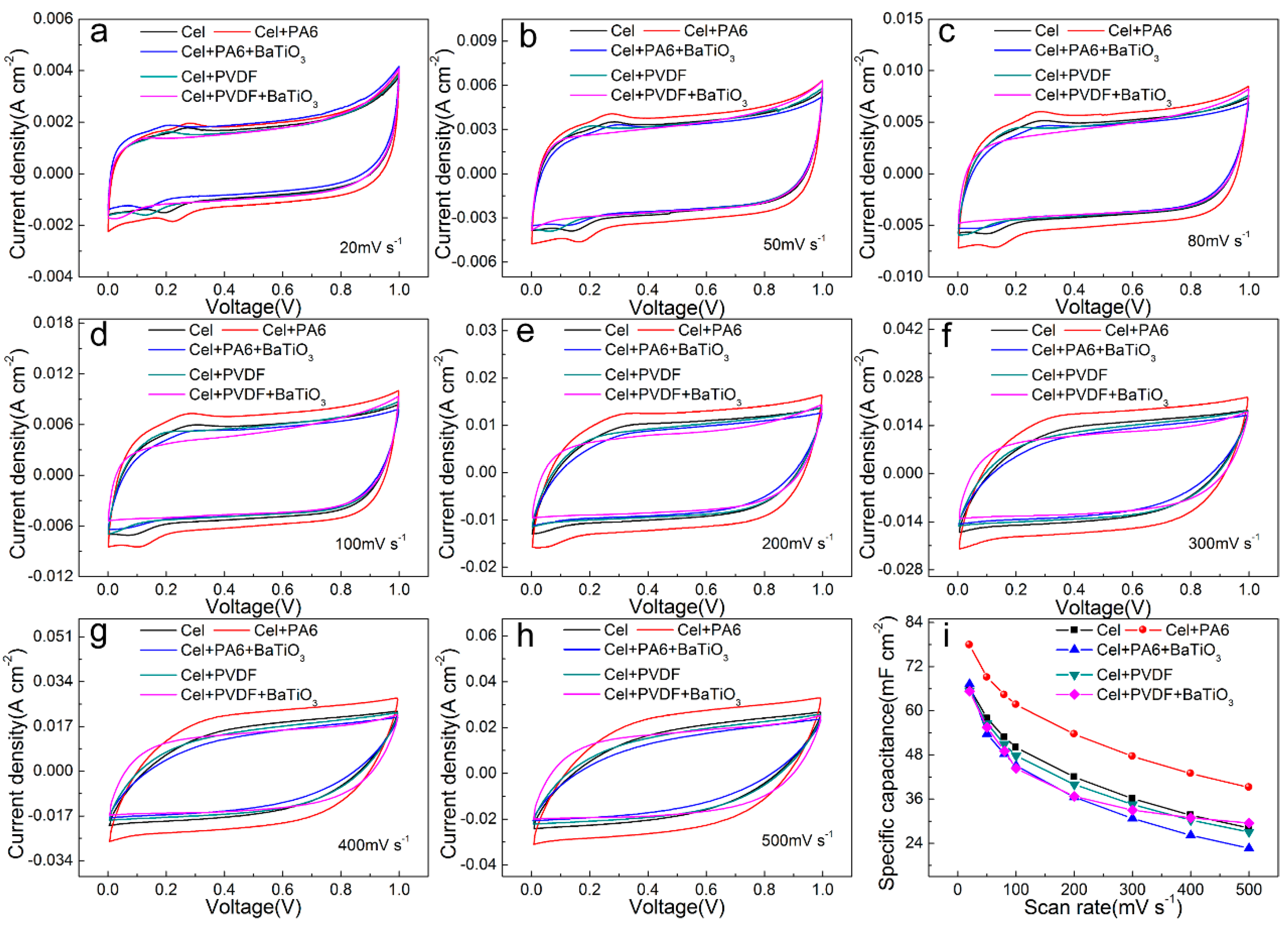


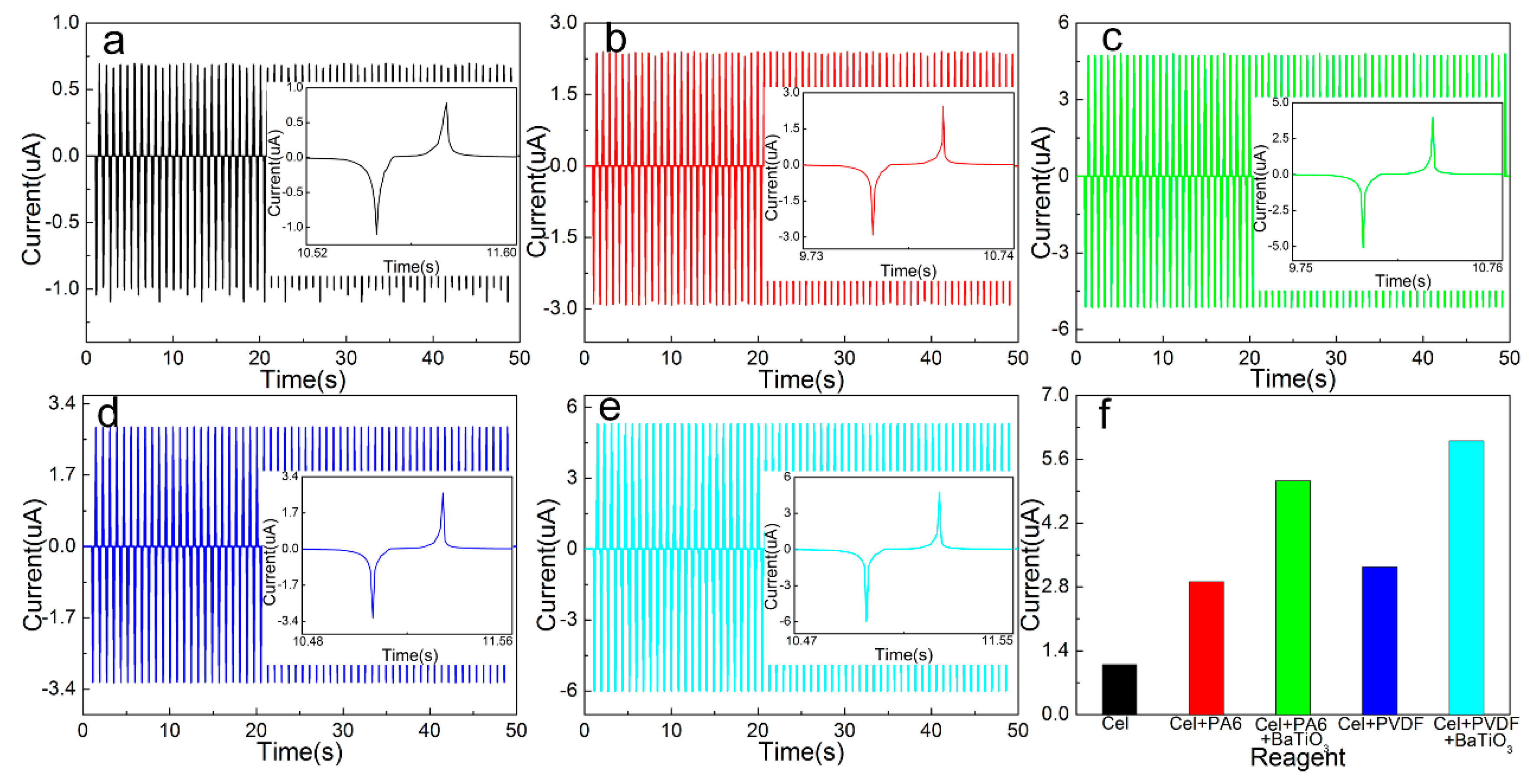
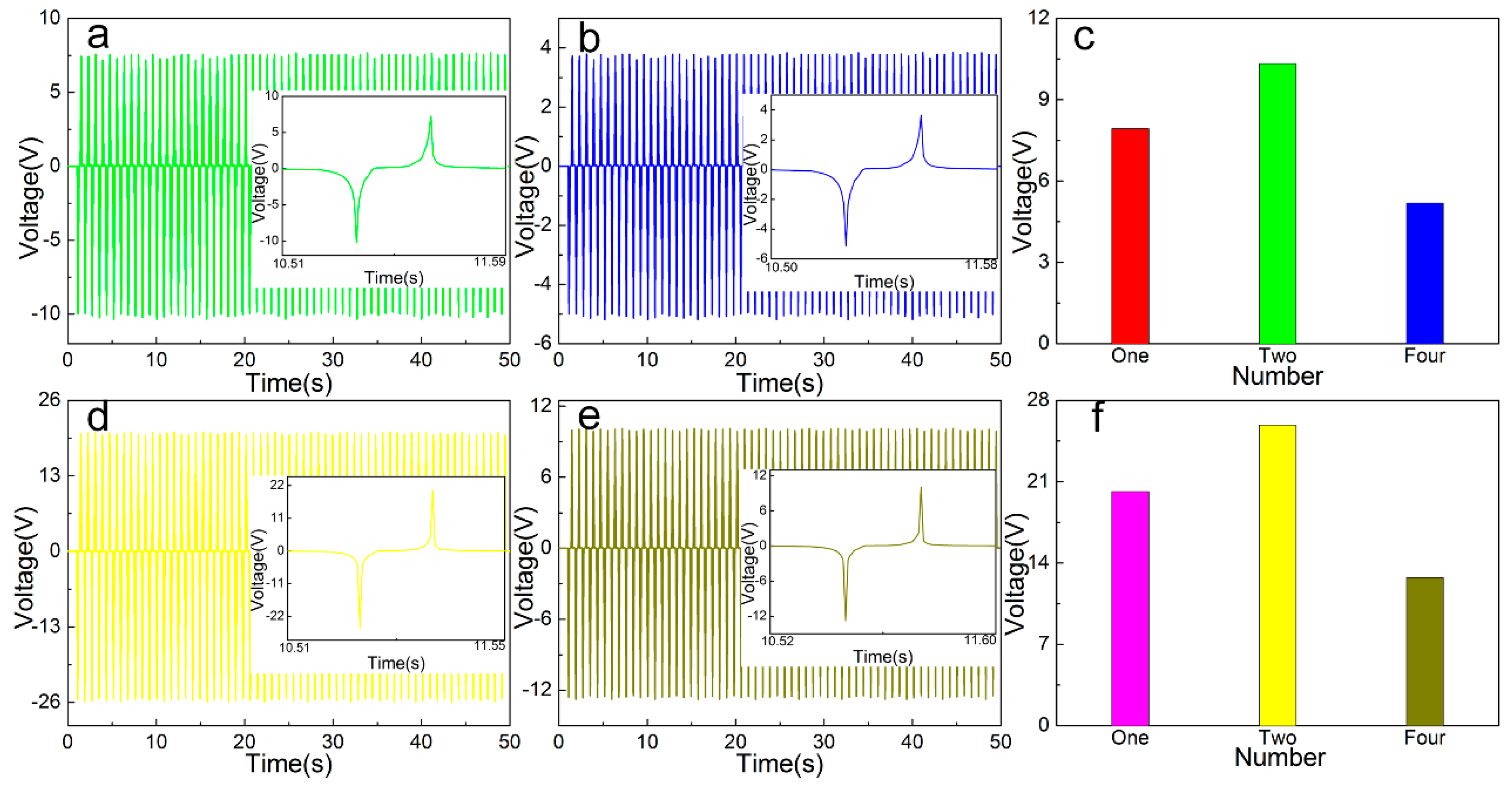
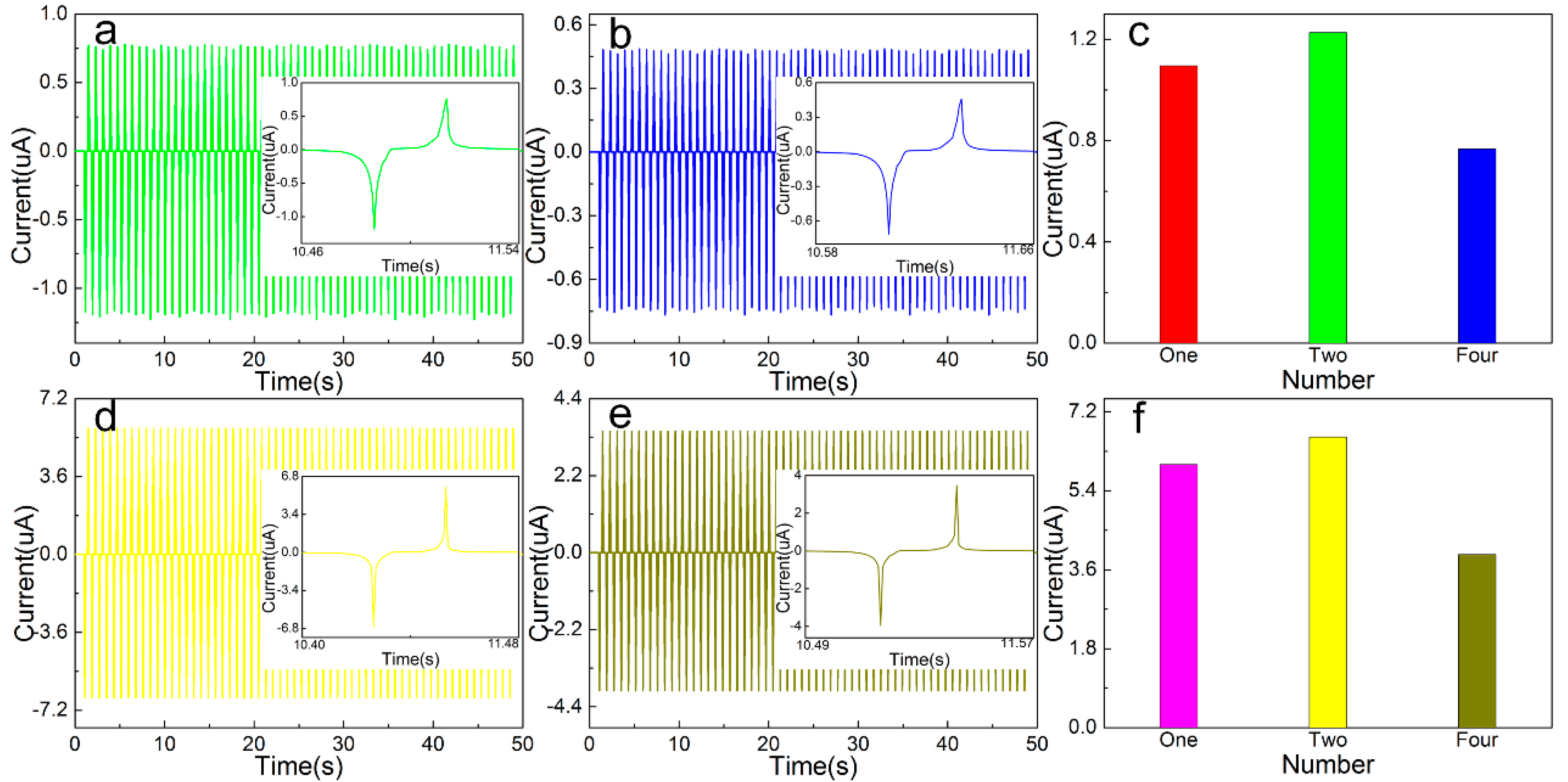

| Reagent | Cel | Cel + PA6 | Cel + PA6 + BaTiO3 | Cel + PVDF | Cel + PVDF + BaTiO3 | |
|---|---|---|---|---|---|---|
| Scan Rate (mv s−1) | ||||||
| 20 | 66.225 | 77.896 | 67.252 | 65.509 | 65.293 | |
| 50 | 57.928 | 69.077 | 53.678 | 56.498 | 55.491 | |
| 80 | 52.807 | 64.34 | 48.245 | 50.942 | 49.077 | |
| 100 | 50.057 | 61.642 | 45.053 | 47.768 | 44.318 | |
| 200 | 42.004 | 53.631 | 36.545 | 39.974 | 36.716 | |
| 300 | 36.112 | 47.611 | 30.721 | 34.529 | 32.986 | |
| 400 | 31.625 | 42.921 | 26.148 | 30.301 | 30.953 | |
| 500 | 28.156 | 39.212 | 22.654 | 27.078 | 29.488 | |
| Reagent | Cel | Cel + PA6 | Cel + PA6 + BaTiO3 | Cel + PVDF | Cel + PVDF + BaTiO3 | |
|---|---|---|---|---|---|---|
| EIS Parameter | ||||||
| Re (Ω) | 1.455 | 1.553 | 1.571 | 1.922 | 1.731 | |
| Rct (Ω) | 7.194 | 3.876 | 5.986 | 6.794 | 4.324 | |
| Cdl (mF) | 0.439 | 0.453 | 0.572 | 0.504 | 0.792 | |
| σ (ms/cm) | 3.029 | 10.423 | 7.947 | 8.613 | 14.738 | |
© 2020 by the authors. Licensee MDPI, Basel, Switzerland. This article is an open access article distributed under the terms and conditions of the Creative Commons Attribution (CC BY) license (http://creativecommons.org/licenses/by/4.0/).
Share and Cite
Sun, Z.; Yang, L.; Liu, S.; Zhao, J.; Hu, Z.; Song, W. A Green Triboelectric Nano-Generator Composite of Degradable Cellulose, Piezoelectric Polymers of PVDF/PA6, and Nanoparticles of BaTiO3. Sensors 2020, 20, 506. https://doi.org/10.3390/s20020506
Sun Z, Yang L, Liu S, Zhao J, Hu Z, Song W. A Green Triboelectric Nano-Generator Composite of Degradable Cellulose, Piezoelectric Polymers of PVDF/PA6, and Nanoparticles of BaTiO3. Sensors. 2020; 20(2):506. https://doi.org/10.3390/s20020506
Chicago/Turabian StyleSun, Zhuangzhi, Lu Yang, Sicheng Liu, Jintao Zhao, Zhiwei Hu, and Wenlong Song. 2020. "A Green Triboelectric Nano-Generator Composite of Degradable Cellulose, Piezoelectric Polymers of PVDF/PA6, and Nanoparticles of BaTiO3" Sensors 20, no. 2: 506. https://doi.org/10.3390/s20020506
APA StyleSun, Z., Yang, L., Liu, S., Zhao, J., Hu, Z., & Song, W. (2020). A Green Triboelectric Nano-Generator Composite of Degradable Cellulose, Piezoelectric Polymers of PVDF/PA6, and Nanoparticles of BaTiO3. Sensors, 20(2), 506. https://doi.org/10.3390/s20020506





